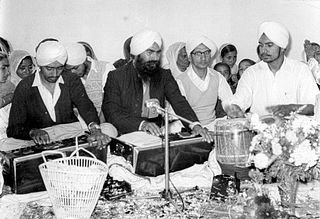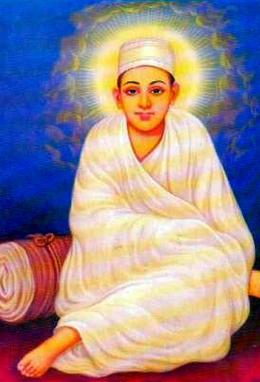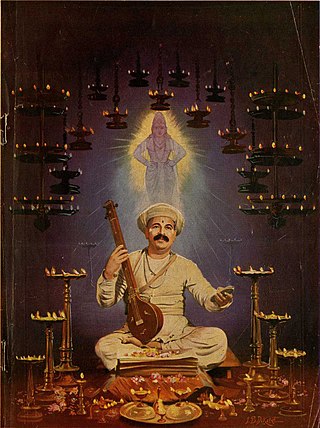Related Research Articles

Kabir (1398–1518) was a well-known Indian mystic poet and saint. His writings influenced Hinduism's Bhakti movement, and his verses are found in Sikhism's scripture Guru Granth Sahib, the Satguru Granth Sahib of Saint Garib Das, and Kabir Sagar of Dharamdas. Today, his poems are not only sung by Hindus and Sikhs, but also by Muslims—especially Sufis.

Bhajan refers to any devotional song with a religious theme or spiritual ideas, specifically among Indian religions, in any language. The term bhajanam means reverence and originates from the root word bhaj, which means to revere, as in 'Bhaja Govindam' . The term bhajana also means sharing.
Bhakti means "attachment, participation, fondness for, homage, faith, love, devotion, worship, purity". It was originally used in Hinduism, referring to devotion and love for a personal god or a representational god by a devotee. In ancient texts such as the Shvetashvatara Upanishad, the term simply means participation, devotion and love for any endeavor, while in the Bhagavad Gita, it connotes one of the possible paths of spirituality and towards moksha, as in bhakti marga.

The Bhakti movement was a significant religious movement in medieval Hinduism that sought to bring religious reforms to all strata of society by adopting the method of devotion to achieve salvation. Originating in Tamilakam during 6th century CE, it gained prominence through the poems and teachings of the Vaishnava Alvars and Shaiva Nayanars before spreading northwards. It swept over east and north India from the 15th century onwards, reaching its zenith between the 15th and 17th century CE.

Sant Dnyaneshwar, also referred to as Dnyaneshwar, Dnyanadeva, Dnyandev or Mauli or Dnyaneshwar Vitthal Kulkarni (1275–1296), was a 13th-century Indian Marathi saint, poet, philosopher and yogi of the Nath and Varkari tradition. In his short life of 21 years, he authored Dnyaneshwari and Amrutanubhav. These are the oldest surviving literary works in the Marathi language, and considered to be milestones in Marathi literature. Sant Dnyaneshwar's ideas reflect the non-dualistic Advaita Vedanta philosophy and an emphasis on Yoga and bhakti towards Vithoba, an incarnation of Lord Vishnu. His legacy inspired saint-poets such as Eknath and Tukaram, and he is one of the founders of the Varkari (Vithoba-Krishna) Bhakti movement tradition of Hinduism in Maharashtra. Dnyaneshwar undertook samadhi at Alandi in 1296 by entombing himself in an underground chamber.

Kirtana, also rendered as Kirtan or Keertan, is a Sanskrit word that means "narrating, reciting, telling, describing" of an idea or story, specifically in Indian religions. It also refers to a genre of religious performance arts, connoting a musical form of narration or shared recitation, particularly of spiritual or religious ideas, native to the Indian subcontinent.
A sant is a human being revered as a "truth-exemplar" for their abnormal of "self, truth, [and] reality" in Indic religions, particularly Hinduism, Jainism, Sikhism, and Buddhism. In Sikhism it is used to describe a being who has attained spiritual enlightenment and divine knowledge and power through union with God.

Sant Tukaram Maharaj, also known as Tuka, Tukobaraya, Tukoba, was a Hindu, Marathi Saint of "Varkari sampradaya" in Dehu village, Maharashtra in the 17th century. He was a bhakt of Lord Pandurang of Pandharpur. He is best known for his devotional poetry called Abhanga, which are popular in Maharashtra, many of his poems deals with social reform.

Ramananda or Swami Ramanand was a 14th-century Vaishnava devotional poet saint, who lived in the Gangetic basin of northern India. The Hindu tradition recognizes him as the founder of the Ramanandi Sampradaya, the largest monastic Hindu renunciant community in modern times.

Hindu music is music created for or influenced by Hinduism. It includes Indian classical music, Kirtan, Bhajan and other musical genres. Raagas are a common form of Hindu music in classical India.

Namdev, also transliterated as Nam Dayv, Namdeo, Namadeva, was a Marathi Vaishnav saint from Narsi, Hingoli, Maharashtra, India within the Varkari tradition of Hinduism. He lived as a devotee of Lord Vitthal of Pandharpur. He is widely regarded as the founder of Varkari tradition.
Sant Mat was a spiritual movement on the Indian subcontinent during the 13th–17th centuries CE. The name literally means "teachings of sants", i.e. mystic Hindu saints. Through association and seeking truth by following sants and their teachings, a movement was formed. Theologically, the teachings are distinguished by inward, loving devotion by the individual soul (atma) to the Divine Principal God (Parmatma). Socially, its egalitarianism distinguishes it from the caste system, and from Hindus and Muslims. Sant Mat is not to be confused with the 19th-century Radha Soami, also known as contemporary "Sant Mat movement".

Sant Dadu Dayal was a poet-saint from Gujarat, India, a religious reformer who spoke against formalism and priestcraft.

Warkari is a sampradaya within the bhakti spiritual tradition of Hinduism, geographically associated with the Indian state of Maharashtra. Warkaris worship Vitthal, the presiding deity of Pandharpur, regarded as a form of Vishnu. Saints and gurus of the bhakti movement associated with the Warkaris include Dnyaneshwar, Namdev, Chokhamela, Eknath, and Tukaram all of whom are accorded the title of Sant. Recent research has suggested that the Varkaris were historically the followers of Krishna.
Hinduism and Sikhism are Indian religions. Hinduism has pre-historic origins, while Sikhism was founded in the 15th century by Guru Nanak. Both religions share many philosophical concepts such as karma, dharma, mukti, and maya although both religions have different interpretation of some of these concepts.

Bhagat Pipa was a Rajput King of Gagaraungarh who abdicated the throne to become a Hindu mystic poet and saint of the Bhakti movement. He was born in the Malwa region of North India in approximately AD 1425.
Vaishnavism is one of the major Hindu denominations along with Shaivism, Shaktism, and Smartism. It is also called Vishnuism since it considers Vishnu as the sole supreme being leading all other Hindu deities, that is, Mahavishnu. Its followers are called Vaishnavites or Vaishnavas, and it includes sub-sects like Krishnaism and Ramaism, which consider Krishna and Rama as the supreme beings respectively. According to a 2010 estimate by Johnson and Grim, Vaishnavism is the largest Hindu sect, constituting about 641 million or 67.6% of Hindus.

Ravidas or Raidas (1267–1335) was an Indian mystic poet-saint of the Bhakti movement during the 15th to 16th century CE. Venerated as a guru in the modern regions of Uttar Pradesh, Bihar, Rajasthan, Gujarat, Maharashtra, Madhya Pradesh, Punjab, and Haryana, he was a poet, social reformer and spiritual figure.
Hindu denominations, sampradayas, traditions, movements, and sects are traditions and sub-traditions within Hinduism centered on one or more gods or goddesses, such as Vishnu, Shiva, Shakti and so on. The term sampradaya is used for branches with a particular founder-guru with a particular philosophy.

Sant Tukaram, also known as Saint Tukaram, is a 1936 Marathi film, produced by Prabhat Film Company and based on the life of Tukaram (1608–50), a prominent Varkari saint and spiritual poet of the Bhakti movement in India. The film was directed by Vishnupant Govind Damle and Sheikh Fattelal and featured Vishnupant Pagnis in the lead role of the saint.
References
- ↑ Robin Rinehart (1 January 2004). Contemporary Hinduism: Ritual, Culture, and Practice. ABC-CLIO. pp. 87–90. ISBN 978-1-57607-905-8 . Retrieved 3 June 2013.
- ↑ Karine Schomer; W. H. McLeod (1 January 1987). The Sants: Studies in a Devotional Tradition of India. Motilal Banarsidass. pp. 2–3. ISBN 978-81-208-0277-3 . Retrieved 3 June 2013.
- ↑ Jacqueline Jones (2009). Performing the Sacred: Song, Genre, and Aesthetics in Bhakti. p. 7. ISBN 978-1-109-06430-8 . Retrieved 3 June 2013.
- ↑ Kenneth L. Woodward (10 July 2001). The Book of Miracles: The Meaning of the Miracle Stories in Christianity, Judaism, Buddhism, Hinduism and Islam. Simon & Schuster. p. 267. ISBN 978-0-7432-0029-5 . Retrieved 3 June 2013.
- ↑ P. 126 A history of Hindu civilisation during British rule By Pramatha Nath Bose OL 67794W
- ↑ P. 48 A History of Indian Literature, 500-1399: From Courtly to the Popular By Śiśira Kumāra Dāsa. New Delhi: Sahitya Akademi (2005) OL 17012582M
- ↑ P. 355 Awakening Indians to India By All India Chinmaya Yuva Kendra. (Paperback) OCLC 296288988
- ↑ Narasimhachari, H. Daniel Smith & M. (1997). Handbook Of Hindu Gods, Goddesses And Saints. Sundeep Prakashan. ISBN 978-81-7574-164-5.